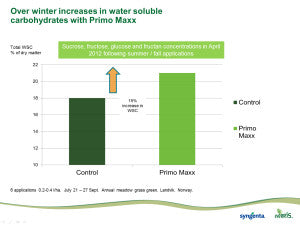Green route to winter disease control

Speaking at a BIGGA Golf Education Day turf management seminar during an Industry show earlier this month, Dr Simon Watson of Syngenta urged turf mangers to: 'Go in Green, to Come out Clean'.
Using a new interactive voting system during the seminar, he instantly showed that 95% of attendees' courses were affected by autumn or winter disease on greens, with over half reporting problems every year.
"Strong, healthy turf going into the winter is paramount to maintain the best possible playing conditions through the winter, and produce more consistent surfaces for the spring." advised Dr Watson. "There is immense value in preparations through the autumn and early winter, to help protect turf through more severe months."
The shoe survey showed that over 40% of greenkeepers believed that building up reserves related to levels of potassium or iron in the turf, when efforts should really be targeted at increasing carbohydrate levels in the plant.
Dr Watson highlighted research that has shown an autumn Primo Maxx programme can be to be highly effective in raising over-winter water soluble carbohydrates. Levels of sucrose, fructose and glucose that can be readily utilised by plants were still over 16% higher in the spring after a Primo Maxx progra

"Crucially, promoting healthy turf through the autumn also reduced winter disease susceptibility," he said. "Independent trials under severe Microdochium Patch (Fusarium) disease risk conditions showed up to 70% reduction in infection over the winter on greens treated with a Primo Maxx programme." The researchers attributed the reduced disease effects to the higher accumulation of carbohydrates in the turf plant tissue.
One of the key attributes of the Primo Maxx treatment is a 30% increase in the average number of chloroplasts in the turf leaf, as demonstrated by research at Syngenta Jealott's Hill. This not only gives turf a more attractive green appearance, but also increases the efficiency of leaves to absorb light and lead to greater carbohydrate assimilation, according to Dr Watson.
Nutritional advice
This potential to increase carbohydrate reserves needs to be carefully matched with appropriate nutritional inputs over the autumn, advised Michael Fance of Everris. "Carbohydrate reserves do respond to increased nitrogen inputs, to a point. But, over feeding leads to excessive top growth that needs to be mown off; soft growth that is more susceptible to disease and poor rooting," he warned.

Mr Fance advocated that autumn high potassium fertiliser applications could help to strengthen turf prior to stressful periods. "It is crucial to get nitrogen levels right and in a form that will support building plant reserves, without triggering lush growth. Greenmaster Liquid High K has low levels of N and P, but supplies the N from three sources to maintain extremely consistent results.
"Furthermore, previously locked-up iron in the soil is released, to enhance colour and turf health, along with a full trace element package to enhance turf health and aid recovery from stress." He added that the Everris TMax formulation is also beneficial to avoid wash-off in wet autumn conditions and to enhance rapid and complete uptake of nutrients into the leaf.
Both Greenmaster Liquid High K and Effect Iron Fe have been proven to assist in the reduction of Microdochium Patch disease over the winter.
Proactive fungicide stratgey
Dr Simon Watson advocated that by promoting healthy turf in the autumn greenkeepers have the best opportunity to prevent disease outbreaks and loss of turf quality during high risk periods of weather conditions conducive to disease.
The show seminar survey showed that whilst most greenkeepers recognise the optimum timing for preventative fungicides, a third still wait to see disease before applying - by which time plants will be under extreme stress and playing surface speed and consistency will be adversely affected, he added.
"STRI trials have repeatedly shown 
Dr Watson reported trials at Birch Grove Golf Club in Essex, where Medallion TL applications in mid and late autumn effectively eliminated any incidence of Microdochium Patch for 90 days after treatment, when over 25% of turf was affected by the continual build-up of disease on untreated area. The trial highlighted the importance product selection to tackle the disease threat, with infection levels following iprodione application reaching 10% of surface area within five weeks of the second treatment and continuing to develop for the rest of the winter.
"It also reiterated application during periods of high risk is crucial to prevent the disease pathogen developing and infection breaking out," he advised. "Over 50% of greenkeepers involved with the show survey were using the GreenCast disease forecasting system to help identify periods of disease risk."
Dr Watson's key tips for winter turf disease control success:
● Build carbohydrate reserves over the autumn
● Alleviate conditions conducive to Microdochium Patch
● Use a preventative Medallion TL programme
● Follow GreenCast to apply ahead of periods of high disease risk
● Use Syngenta XC Nozzles to achieve even spray coverage
● Apply a fungicide in the spring if disease pressure is high
For turf specific agronomy and product information go to www.greencast.co.uk
Syngenta turf products are distributed in the UK by Everris. www.everris.co.uk
Greenmaster fertilisers are available in Pitchcare shop
